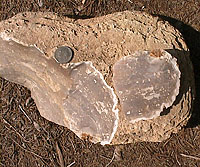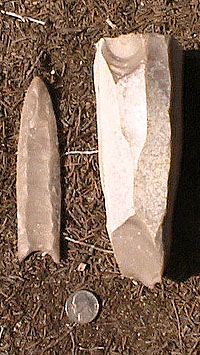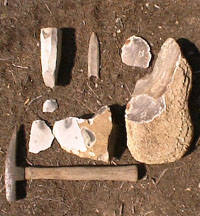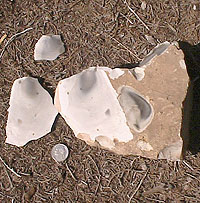Hamilton County Flint
This flint from Hamilton County occurs in massive lag deposits on upland plain surfaces near Evant, Texas as well as in the gravels along the creeks. Hamilton County flint may originate in the Walnut and Comanche Peak geological formations – some of it is distinct from many cherts from the Edwards Limestone. There are several variations, three of which are referred to here as Evant Gray, Evant Mottled and Hamilton Mottled. All varieties are mostly of medium to large cobble size, averaging roughly 15 - 25 centimeters in length. Most pieces were fairly flat cobbles of irregular shape, with smaller pieces being more rounded.
Both Evant varieties are of high quality, although some of the mottled material can be improved by heat treating. Evant Gray is similar to Georgetown flint in most respects and no doubt was a favored material of aboriginal knappers, going back to Clovis times. Evant Mottled has a primary matrix of grays and browns, often with considerable mottling of several shades. This locale is home to the Evant Cores, a cache of three Clovis polyhedral cores made of Evant Gray (Goode and Mallouf, 1991, Current Research in Pleistocene). At least two other Clovis cores are known from the region, and are also made of Evant Gray. Goode suspects that it was not just the quality, but also the shape of cobbles (rounded and elongate) that made this a favored material for Clovis blade making.
The Hamilton Mottled material ranges from medium/large cobble size up to sizeable boulders (50 - 60 centimeters in diameter or larger). Generally speaking, this material is of lesser quality, but it can definitely be improved by heat-treating. Mottles of various browns and grays occur within a primary matrix of light to pale brown and grayish brown. Prehistoric tools made of these flints occur in a local collection, which also reveals the considerable variety of materials in this region.
![]()



